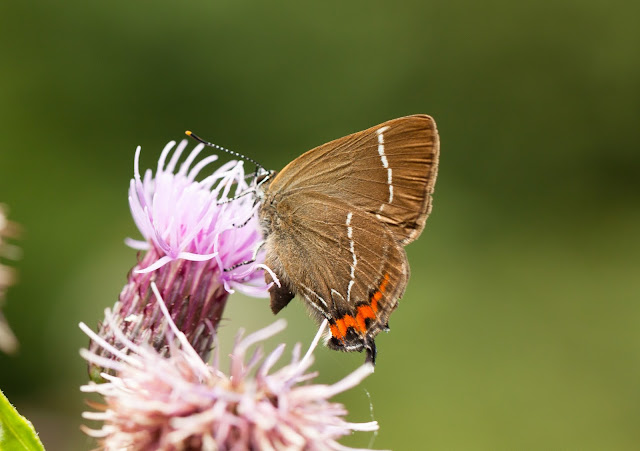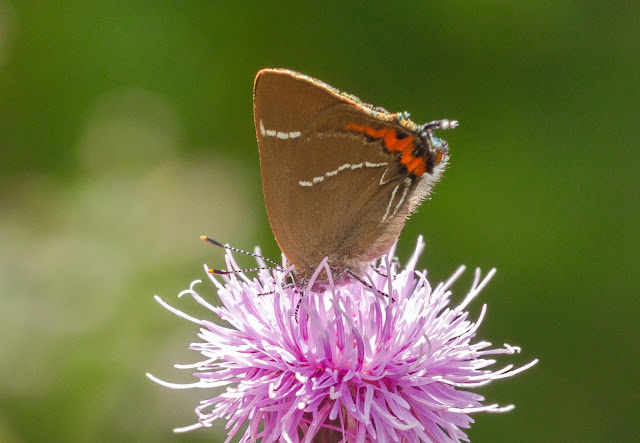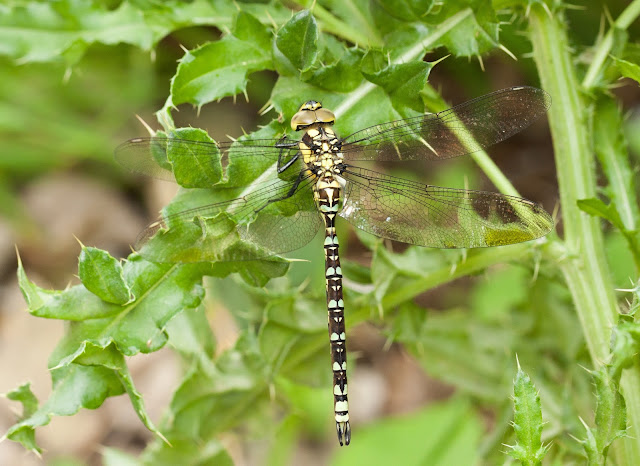White-letter Hairstreak is a
butterfly that despite being readily recorded in both Hartford and Leftwich, I
hadn’t as of yet managed to catch up with. Often residing high up in the
treetop canopy where they can be seen tumbling through the sky, I decided to
seek out this often elusive butterfly at Brockholes Nature Reserve in
Lancashire. Here the colony can be found on a large bramble bush next to the
path, where individuals can give great low down views as they nectar on the
flowers.
Arriving at Brockholes just
after lunch, we headed straight for the bramble bush in question at the
entrance to Boilton Woods and immediately discovered that this small patch of
vegetation was a small haven for butterflies - Meadow Browns, Gatekeepers and Ringlets
were all in abundance whilst several showy Commas and Red Admirals settled on
the flowers to feed.
With no sign of any
White-letter Hairstreaks fluttering around either the top of the solitary Elm
tree or the brambles below, we decided to stick it out and wait until we
spotted one (whilst getting absolutely bitten alive by the Horse Flies – not
putting on insect repellent was a huge mistake!)
Luckily another enthusiast
also on a mission to find the Hairstreaks arrived, and after phoning his local
contact we heard they had been favouring a patch of thistles just a few feet
further down the slope. Staking this area out, sure enough within a few minutes
our companion had spotted one, happily nectaring on the purple flowers.
Getting closer to admire this stunning butterfly in more detail (and getting severely nettled in the process!) we could clearly see the diagnostic orange band on the underwings and the delicately marked white ‘W’ alongside. Unlike the Black Hairstreaks I saw at the beginning of the month, there were no black spots running along the edge of the wing – the key point in separating these two similar butterflies.
After a while, the butterfly fluttered off in to the air, and within seconds had completely vanished, making it impossible to track its whereabouts.
Getting closer to admire this stunning butterfly in more detail (and getting severely nettled in the process!) we could clearly see the diagnostic orange band on the underwings and the delicately marked white ‘W’ alongside. Unlike the Black Hairstreaks I saw at the beginning of the month, there were no black spots running along the edge of the wing – the key point in separating these two similar butterflies.
After a while, the butterfly fluttered off in to the air, and within seconds had completely vanished, making it impossible to track its whereabouts.
Throughout the afternoon,
several more individuals were spotted on the large bramble bush, with another
perched out of reach on a nearby tree, only visible through binoculars. With
the thistles offering the best vantage point photography wise, I decided to
stake it out here for the rest of the afternoon. Sure enough, another (possibly
the same) individual landed in the thistles, again allowing a fantastically
close approach.
In addition to the abundance of butterflies, several dragonflies patrolled the area, with Southern Hawkers and Common Darters flying around the small patch of brambles, as well as a fantastic Emperor Dragonfly we spotted resting on a perch in the middle of the bush.
In addition to the abundance of butterflies, several dragonflies patrolled the area, with Southern Hawkers and Common Darters flying around the small patch of brambles, as well as a fantastic Emperor Dragonfly we spotted resting on a perch in the middle of the bush.
As Elm is the sole foodplant
for White-letter Hairstreaks, there were fears this secretive species may have
become extinct in Britain due to the catastrophic effect of Dutch Elm disease
in the 1970’s and early 1980’s. Thankfully surviving colonies were sought out
to gain a greater understanding of their distribution, and several new colonies
were discovered in the process. With an effort to find disease resistant Elms
that are able to support the Hairstreak caterpillars, there is considerable
hope for the future. Luckily, Wych Elm (the Hairstreaks favoured species) seems
to be the most resistant to the disease.
Colonies can also be extremely
small, sometimes consisting of just a few dozen individuals, and may even be
contained on just the one tree (often on the outer edge of a wood) like the
population at Brockholes. With
White-letter Hairstreaks resting in the tops of the trees during the day, early
morning and late afternoon is the best time to these dainty butterflies as they
come down to the ground to feed on their favoured thistles and brambles.
A fantastic butterfly to
finally see and one which means I have now seen all species of Hairstreak in
the UK!




No comments:
Post a Comment